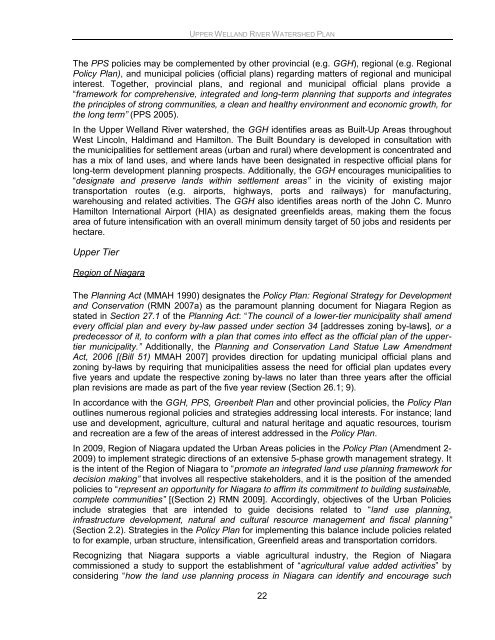Upper Welland River Watershed Plan - Niagara Peninsula ...
Upper Welland River Watershed Plan - Niagara Peninsula ...
Upper Welland River Watershed Plan - Niagara Peninsula ...
Create successful ePaper yourself
Turn your PDF publications into a flip-book with our unique Google optimized e-Paper software.
UPPER WELLAND RIVER WATERSHED PLANThe PPS policies may be complemented by other provincial (e.g. GGH), regional (e.g. RegionalPolicy <strong>Plan</strong>), and municipal policies (official plans) regarding matters of regional and municipalinterest. Together, provincial plans, and regional and municipal official plans provide a“framework for comprehensive, integrated and long-term planning that supports and integratesthe principles of strong communities, a clean and healthy environment and economic growth, forthe long term” (PPS 2005).In the <strong>Upper</strong> <strong>Welland</strong> <strong>River</strong> watershed, the GGH identifies areas as Built-Up Areas throughoutWest Lincoln, Haldimand and Hamilton. The Built Boundary is developed in consultation withthe municipalities for settlement areas (urban and rural) where development is concentrated andhas a mix of land uses, and where lands have been designated in respective official plans forlong-term development planning prospects. Additionally, the GGH encourages municipalities to“designate and preserve lands within settlement areas” in the vicinity of existing majortransportation routes (e.g. airports, highways, ports and railways) for manufacturing,warehousing and related activities. The GGH also identifies areas north of the John C. MunroHamilton International Airport (HIA) as designated greenfields areas, making them the focusarea of future intensification with an overall minimum density target of 50 jobs and residents perhectare.<strong>Upper</strong> TierRegion of <strong>Niagara</strong>The <strong>Plan</strong>ning Act (MMAH 1990) designates the Policy <strong>Plan</strong>: Regional Strategy for Developmentand Conservation (RMN 2007a) as the paramount planning document for <strong>Niagara</strong> Region asstated in Section 27.1 of the <strong>Plan</strong>ning Act: “The council of a lower-tier municipality shall amendevery official plan and every by-law passed under section 34 [addresses zoning by-laws], or apredecessor of it, to conform with a plan that comes into effect as the official plan of the uppertiermunicipality.” Additionally, the <strong>Plan</strong>ning and Conservation Land Statue Law AmendmentAct, 2006 [(Bill 51) MMAH 2007] provides direction for updating municipal official plans andzoning by-laws by requiring that municipalities assess the need for official plan updates everyfive years and update the respective zoning by-laws no later than three years after the officialplan revisions are made as part of the five year review (Section 26.1; 9).In accordance with the GGH, PPS, Greenbelt <strong>Plan</strong> and other provincial policies, the Policy <strong>Plan</strong>outlines numerous regional policies and strategies addressing local interests. For instance; landuse and development, agriculture, cultural and natural heritage and aquatic resources, tourismand recreation are a few of the areas of interest addressed in the Policy <strong>Plan</strong>.In 2009, Region of <strong>Niagara</strong> updated the Urban Areas policies in the Policy <strong>Plan</strong> (Amendment 2-2009) to implement strategic directions of an extensive 5-phase growth management strategy. Itis the intent of the Region of <strong>Niagara</strong> to “promote an integrated land use planning framework fordecision making” that involves all respective stakeholders, and it is the position of the amendedpolicies to “represent an opportunity for <strong>Niagara</strong> to affirm its commitment to building sustainable,complete communities” [(Section 2) RMN 2009]. Accordingly, objectives of the Urban Policiesinclude strategies that are intended to guide decisions related to “land use planning,infrastructure development, natural and cultural resource management and fiscal planning”(Section 2.2). Strategies in the Policy <strong>Plan</strong> for implementing this balance include policies relatedto for example, urban structure, intensification, Greenfield areas and transportation corridors.Recognizing that <strong>Niagara</strong> supports a viable agricultural industry, the Region of <strong>Niagara</strong>commissioned a study to support the establishment of “agricultural value added activities” byconsidering “how the land use planning process in <strong>Niagara</strong> can identify and encourage such22
















